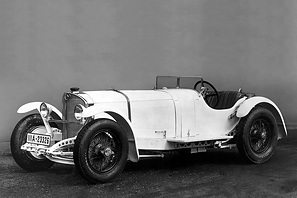After three years of victories and top placings, especially for the SSK racing sports car, the fast-moving world of motorsport held new challenges in store for the Mercedes-Benz works team at the beginning of the 1930s. While the SSK in the hands of private drivers continued to achieve countless successes for years to come in events that were mostly played out rather less in the limelight, new players had entered the scene in the top-level sport, where factory cars and top drivers battled it out in the biggest and most important races.
During the 1920s, Alfa Romeo and Bugatti had designed a series of ultra-modern, powerful and, in terms of design, comparatively dainty, lightweight racing cars whose considerable qualities made them serious rivals for the racing touring cars and racing sports cars of Mercedes-Benz. Even for the SSK, which was so superior, the competitive situation at the end of 1930 was such that, under the aegis of Daimler-Benz head of development Dr Hans Nibel, a final evolution model of the W 06 series was conceived, despite difficult economic circumstances, in order to keep the new competitors at bay.
Nibel clearly recognised what was technically necessary: the new development stage had to deliver more power, while at the same time reducing weight in a way that would be sustainable. The head of development and his team put all their experience to the test and created the SSKL - for "Super-Sport-Kurz-Leicht", or "Super-Sport-Short-Light" - a thoroughbred works racing car for the 1931 motor racing season, which marked the high and final point of the successful W 06 series. Incidentally, its type designation was originally not used officially, or at least not consistently: thus, the total of four vehicles built were designated in the order books of Daimler-Benz AG as "SSK, 1931 Model". It was not until a year later that the media coined the now common abbreviation "SSKL".
Characteristic of the SSKL was an abundance of smaller and larger weight-reducing holes drilled in load-bearing and non-load-bearing parts of the chassis and body substructure as well as in certain detachable body parts. In addition, the wall thickness of the U-shaped pressed steel frame profiles was reduced. In order not to endanger the stability of the overall design, the longitudinal spars in the area of the engine and the front bearing points of the rear leaf springs were reinforced with attached metal sheets. The result of these efforts was a weight saving of 125 kg. Ready to drive, the SSKL weighed only 1352 kg instead of the 1520 kg of an SSK in the most recent stage of development and was thus hardly heavier than its most important challengers among the racing sports cars.
In parallel to reducing the vehicle's weight, engine designer Albert Heess did everything he could to coax even more peak power out of the large-volume supercharged six-cylinder, which was no longer quite up-to-date in terms of its design. In doing so, he made use of classical methods: in order to achieve an increased delivery rate of the 18-rib Roots blower, he changed its drive ratio and also reversed the operating mode of the compressor - in the SSKL it ran continuously and could be disengaged at the driver's request by means of a lever below the steering wheel. In line with the increased blower throughput, Heess enlarged the disc diameter of the intake and exhaust valves by 4 mm to 56 mm with a view to optimising the gas exchange in the combustion chamber. The measures to increase performance were rounded off by a modified crankshaft, which was adapted to the higher working pressures with the help of larger counterweights on the crank pins.
The 7.1-litre engine responded to these interventions with a huge leap in performance: instead of the 180 hp/132 kW without and 250 hp/184 kW with compressor that had been available in the SSK, the revised power unit now provided 240 hp/177 kW at 2900 rpm without and 300 hp/221 kW at 3400 rpm with compressor. The resulting power/weight ratio of only 4.5 kg/hp made the SSKL a competition vehicle that, in the hands of talented drivers, was almost impossible to beat, especially in hillclimbs and road races.
The superiority of the SSKL became immediately apparent with the start of the 1931 racing season. Rudolf Caracciola achieved a sensational result right from the car's first outing at the Mille Miglia, the already legendary 1000-mile race through Italy. He was the first non-Italian starter to win the road race from Brescia to Rome and back, which had been held since 1927, in an SSKL against strong local drivers and marques.
In 1931, further successes followed for the SSKL, especially in hillclimbs, for example in the international races for the European Hill-Climb Championship, but also on the circuit, for example in the Eifel Race on the Nürburgring, in the German Grand Prix held at the same venue, where Caracciola prevailed with the SSKL against the likes of Louis Chiron and Achille Varzi in Bugatti T51s and Tazio Nuvolari in Alfa Romeo 8C 2300s, or on the AVUS in Berlin. Besides Caracciola, the main protagonists at the wheel of the SSKL were Manfred von Brauchitsch and Hans Stuck.
Rudolf Caracciola secured the title of European Hillclimb Champion in the sports car category at the end of a glorious début season in the SSKL. In 1932 and 1933 - Caracciola had moved to Alfa Romeo after Daimler-Benz had had to discontinue its motorsport involvement for economic reasons - von Brauchitsch and Stuck continued to dominate the hillclimb scene in the SSKL. Stuck succeeded Caracciola as European Hillclimb Champion in 1932.
From 1934 onwards, Daimler-Benz turned its full factory attention to racing cars and Grand Prix sport - the era of the legendary Mercedes-Benz Silver Arrows began.


